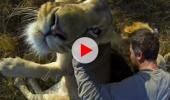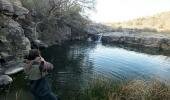Words: Alan Hobson | Photos: Courtesy of The Angler & Antelope
The Karoo savannah, comprising mostly of grass, Karoo bush, and thorn trees, (acacia Karoo) is ideal for goats and more specifically Angoras. It’s this combination of grazing and browsing that allows the goats to thrive in this harsh environment. Hardly the type of landscape one would imagine playing host to fly fishing opportunities for giant trout.
Giant trout is what I had promised Bryan, so you can imagine his look of total disbelief when I stopped on the deserted Andries Vosloo Bridge that crosses the Little Fish River. “Seriously, giant trout here?” he questioned. As we climbed over the fence, even the Angora goats eyed us curiously (or was it also disbelief), as they came closer to inspect our rather odd dress code of waders, fanny packs, rucksacks, and fly fishing vests. Eager to prove my point, we scrambled along the goat path down to the water, a little difficult when you are somewhat bigger than goats, sometimes on our hands and knees to clatter through the thorn trees, guiding the fly rod carefully through the open spaces. Bryan stood paralysed in amazement as he gazed at the pool in front of him, lined by thick bush, reeds, and thorn trees.
Part of his astonishment was trying to conceive that there were indeed giant trout here, as we had stopped literally around the corner and looked upon a dry riverbed. In the upper reaches of the Little Fish River, the fountain-fed water is mostly underground, which cools the water during the hot Karoo summers sufficiently for the trout to survive in the sporadic, deep pools within the riverbed.
We positioned ourselves about six feet back from the water’s edge, kneeling down to lower our profile. Bryan proceeded to false cast over the rocks and only on the final presentation stroke did he bring the rod over the water so the line could follow. It landed just next to the rocky ledge, placing the fly in the gurgling bubble line, allowing the current to move the fly downstream. He carefully twitched the fly back, mimicking an insect, a mayfly nymph that had been dislodged and was now trying to swim out of the current to safety. This is exactly where the fish lie, in the slack current or back eddy where they don’t have to expend any energy and have the flow of the water bring their food to them.
It is sensible to rig your leader with a strike indicator, usually something bright and that floats well. You will find various options available on the market. The strike indicator allows you to gauge the depth of the water so that you can keep the fly just off the bottom of the riverbed. It also allows you to watch the speed your fly is drifting at in the water, as you need to ensure your fly is moving at the same speed as the water, so that it looks as natural as possible. This is called a drag-free drift. Most importantly, any unusual movement from the indicator means a fish has picked up your fly. That is when you must strike, to set the hook. When you see an angler with a tight, wrenched jaw and solemn stare over the water, they are probably focussing on their indicator and not planning their next meeting with their bank manager.
Bryan reacted to the sudden bob of his indicator, but too slowly and missed the take. On the following presentation, his focus was rigid and paid dividends, as he had his first Karoo trout on the end of the line and was beaming from ear to ear. Bryan was chuffed.
I then suggested we move to the tail of the pool and fish directly into the current. After negotiating the goat track through the thorns, we settled in at the tail of the pool. Third cast and Bryan had a heavyweight doing battle, evident by the shriek of joy he yodelled as the fight went back and forth. Finally he brought a beautiful 1,6 kg trout to the net, the glint of satisfaction in his eyes said it all as he released the fish to live another day.
We moved up the little Fish River to target a few other pools nestled amongst huge poplar trees. I suggested that Bryan fish the bigger pool and let me tackle the overgrown pool. The arrangement was whoever caught the first fish would holler, so the other person could come and take photographs. Truth is I knew that my pool held two monster fish, as one of our club members had sheepishly admitted that he had spent a whole day throwing every fly in his box at them without success. A few weeks later, I managed to get one of my American clients to hook one of these monsters, but it fought back so aggressively and with a ferocious flick of its head, it snapped the leader on a submerged tree.
The opportunity to finally have a crack at these wily characters stepped up my pulse rate a notch, as I crouched into the Angora goat position and sidled up quietly to the water. I was at an advantage, as the previous failed attempts required a change in strategy, a 15-foot leader and no strike indicator, as it might spook the fish, and a very slow twitch hardly moving the #14 mayfly nymph. A gap between the branches of a berg karee and poplar tree only just made a cast upstream manageable. The pool is no bigger than your lounge at home, so it's unbelievable to think this small pool could hold giant trout.
If there is one technique fly fishermen should make a habit of, it would be to focus on lifting the rod very slowly at the end of your retrieve before making the next cast. Fish often follow the fly until the bitter end and as one lifts the fly out of the water they pounce on it. Exactly what happened here and then all hell broke loose as the fish scurried up and down either side of the pool; first under the roots of the big trees and then back down the rocky undercuts on the opposite bank. He was an old warrior.
I yelled for Bryan to come and take photographs and document this legendary battle. This warrior came with a serious reputation, just like a seasoned heavyweight champion earns his after having bruised a few egos. As he came to the net, I was overcome with respect, a giant in every sense of the word.



